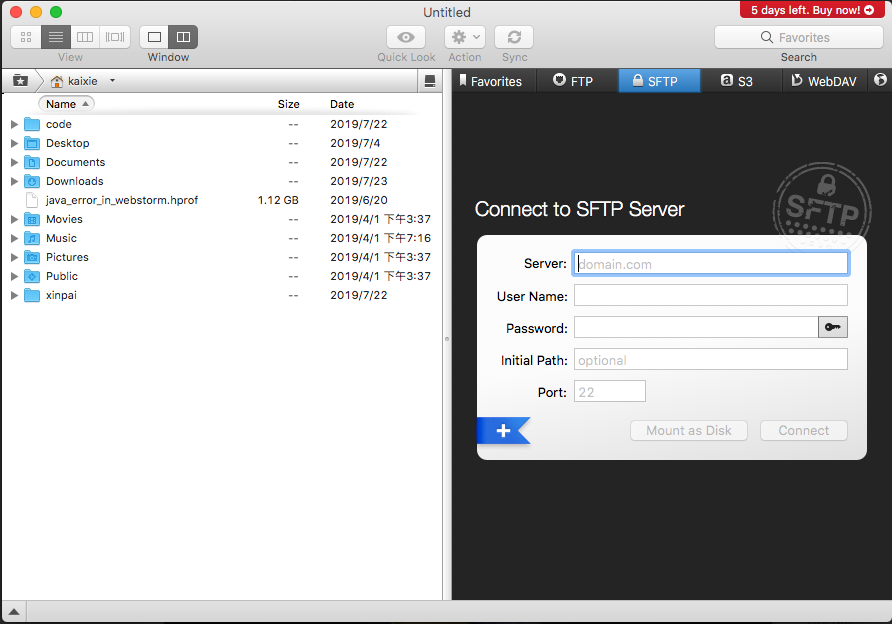Introduction: Using vue+element-ui to develop the front-end, node.js+express+mongodb to develop the back-end, deployed to the Ali cloud server (mirror information Node.js).
1. Apply for Aliyun Server
You can apply for the cheapest one to practice. CentOS is selected for system image and Node.js is selected for application image (version 4.8.4, need to be upgraded).
2. Login Server
Open the terminal, enter sudo-i to switch users, and enter ssh root@public network ip
sudo -i ssh root@public network ip Enter your password (if it's the first time you need to type yes based on the prompt)
Password needs to be set in Server Operations-Remote Connection, as shown in Figure 1
3. Connecting Server with transmit Client
download transmit
Player sftp, enter server public network ip, user name root, password * click connect
Connecting to the server, you can upload the code to the corresponding folder of the server and recommend the home folder.
4. Modify nginx
vi /usr/local/nginx/conf/nginx.conf
Amend as follows
server { listen 80; server_name _; return 404; } server { listen 80; server_name Your domain name.com www.Your domain name.com; #charset koi8-r; #access_log logs/host.access.log main; location / { // Here, all requests are forwarded to the service started by node through nginx proxy_pass http://127.0.0.1: port number of node JS configuration; } #error_page 404 /404.html; # redirect server error pages to the static page /50x.html # error_page 500 502 503 504 /50x.html; location = /50x.html { root html; } # proxy the PHP scripts to Apache listening on 127.0.0.1:80 # #location ~ \.php$ { # proxy_pass http://127.0.0.1; #} # pass the PHP scripts to FastCGI server listening on 127.0.0.1:9000 # #location ~ \.php$ { # root html; # fastcgi_pass 127.0.0.1:9000; # fastcgi_index index.php; # fastcgi_param SCRIPT_FILENAME /scripts$fastcgi_script_name; # include fastcgi_params; #} # deny access to .htaccess files, if Apache's document root # concurs with nginx's one # #location ~ /\.ht { # deny all; #} }
Common methods for starting nginx /usr/local/nginx/sbin/nginx / usr/local/nginx/sbin/nginx-t# Check that the configuration file is correctly written / Smooth restart of usr/local/nginx/sbin/nginx-s reload#Nginx / usr/local/nginx/nginx.conf# configuration file.
5. Upgrade node version
After entering the server through the terminal, enter nvm list
[root@iz2zeaxcuikwvill2ho8yiz bin]# nvm list v4.8.4 -> v12.6.0 default -> stable (-> v12.6.0) node -> stable (-> v12.6.0) (default) stable -> 12.6 (-> v12.6.0) (default) iojs -> N/A (default) lts/* -> lts/dubnium (-> N/A) lts/argon -> v4.9.1 (-> N/A) lts/boron -> v6.17.1 (-> N/A) lts/carbon -> v8.16.0 (-> N/A) lts/dubnium -> v10.16.0 (-> N/A) [root@iz2zeaxcuikwvill2ho8yiz bin]#
v12.6.0 is used here.
Install stable version with nvm install stable
nvm use stable specifies a version
Change the default version with nvm alias default stable so that you don't have to switch versions every time
If we use es6 grammar in our node project, we need to upgrade the node version like this
6. Installing pm2
Global Installation
npm install pm2 -g
Use pm2 to start node project and maintain process
pm2 start ./bin/www // Start the project pm2 list // View the current startup item pm2 restart id // Restart the specified project pm2 logs // View node logs
7. Installation of mongodb
If there is mongodb in the project / usr/local, there is no need to install it
cd /usr/local wget https://fastdl.mongodb.org/linux/mongodb-linux-x86_64-3.4.6.tgz
Unzip, rename folder name
tar zxvf mongodb-linux-x86_64-2.6.0.tgz mv mongodb-linux-x86_64-2.6.0 mongodb
Create data and log storage directories
mkdir /var/mongodb mkdir /var/mongodb/data mkdir /var/mongodb/logs
Open the rc.local file and add the CentOS startup entry:
vim /etc/rc.d/rc.local
Append the mongodb startup command to this document and let mongodb start itself:
/usr/local/mongodb/bin/mongod --dbpath=/var/mongodb/data --logpath /var/mongodb/logs/log.log --logappend --auth --port 27017 --fork Note -- auth has this attribute and needs to verify login
Start mongo
/usr/local/mongodb/bin/mongod --dbpath=/var/mongodb/data --logpath /var/mongodb/logs/log.log --logappend --auth --port 27017 --fork
Start PM2 start. / bin / www, and then access public network ip